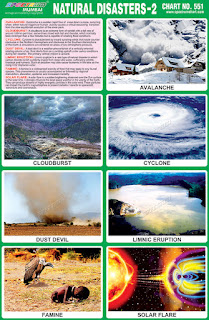 |
| Natural Disasters Chart |
Spectrum Chart - 551 : Natural Disasters 2
1. Avalanche - An avalanche (also called a
snowslide) is a rapid flow of snow down a sloping surface. Large
avalanches may carry stones, boulders and trees with them. They may
bury people under them. If the people are not found rapidly enough by
rescue teams they will die of suffocation (not getting enough air) or
of hypothermia (freezing cold).
2. Cloudburst – A cloudburst is an
extreme amount of precipitation, sometimes accompanied by hail and
thunder, that normally lasts no longer than a few minutes but is
capable of creating flood conditions. A cloudburst can suddenly dump
large amounts of water. In the Indian subcontinent, a cloudburst
usually occurs when a monsoon cloud drifts northwards, from the Bay
of Bengal or Arabian Sea across the plains, then onto the Himalaya
and bursts, bringing rainfall as high as 75 mm per hour.
3. Cyclone - A
cyclone is a large scale air mass that rotates around a strong centre
of low pressure. They are usually characterised by inward spiralling
winds that rotate counter clockwise in the Northern Hemisphere and
clockwise in the southern. Cyclone is the general term for a variety
of low pressure system types, such as tropical cyclones, extra
tropical cyclones and tornadoes.
4. Dust Devil – A dust devil is a
strong, well-formed and relatively long-lived whirlwind, ranging from
small to large. The primary vertical motion is upward. Dust devils
are usually harmless, but can on rare occasions grow large enough to
pose a threat to both people and property. Dust devils form when hot
air near the surface rises quickly through a small pocket of cooler,
low-pressure air above it. If conditions are just right, the air may
begin to rotate.
5. Limnic Eruption – A limnic eruption,
also referred to as a lake overturn, is a rare type of natural
disaster in which dissolved carbon dioxide(CO2) suddenly
erupts from deep lake water, suffocating wildlife, livestock and
humans. Such an eruption may also cause tsunamis in the lake as the
rising CO2 displaces water. Scientists believe
earthquakes, volcanic activity or explosions can trigger such an
eruption. Lakes in which such activity occurs may be known as
limnically active lakes or exploding lakes.
6. Famine - A famine is a widespread
scarcity of food, caused by several factors including crop failure,
population imbalance or government policies. This phenomenon is
usually accompanied or followed by regional malnutrition, starvation,
epidemic and increased mortality. Some countries, particularly in
sub-Sahara Africa, continue to have extreme cases of famine.
7. Solar Flare – A solar flare is a
sudden flash of brightness observed near the Sun's surface. The flare
ejects clouds of electrons, ions, and atoms through the corona of the
sun into space. These clouds typically reach Earth a day or two after
the event. Solar flares affect all layers of the solar atmosphere.
X-rays and UV radiation emitted by solar flares can affect Earth's
ionosphere and disrupt long-range radio communications.

No comments:
Post a Comment